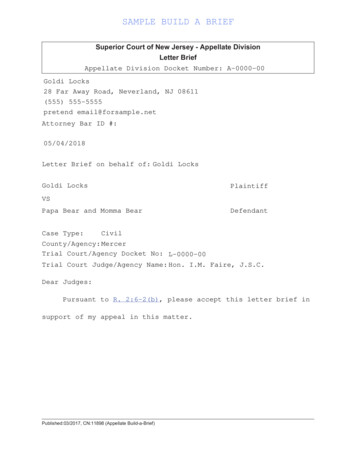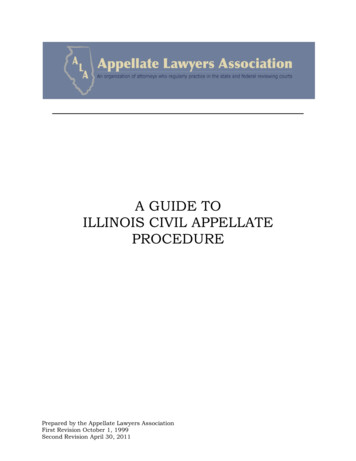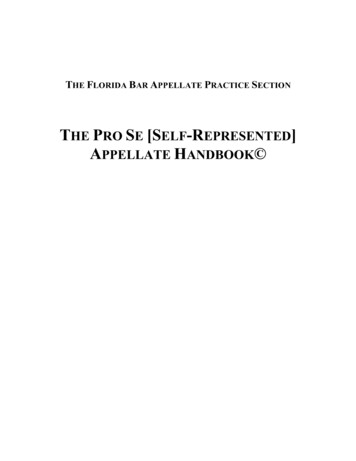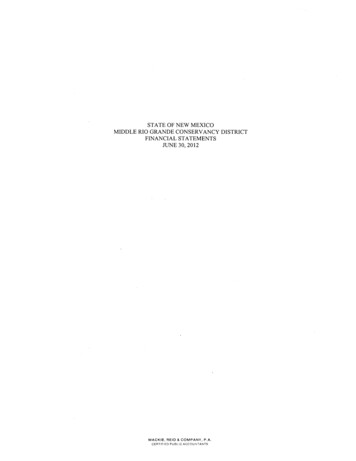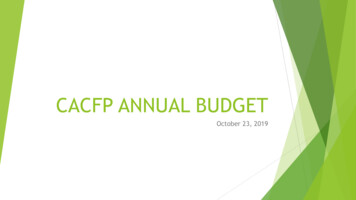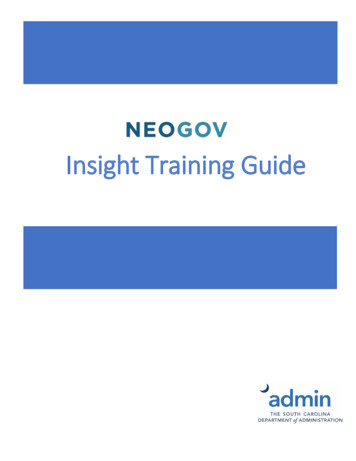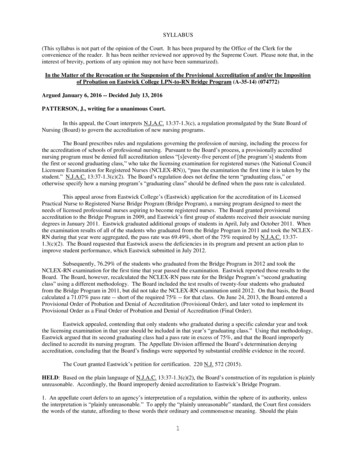
Transcription
NOT FOR PUBLICATION WITHOUT THEAPPROVAL OF THE APPELLATE DIVISIONSUPERIOR COURT OF NEW JERSEYAPPELLATE DIVISIONDOCKET NO. A-2120-15T3JUAN MORALES-HURTADO,Plaintiff-Appellant,APPROVED FOR PUBLICATIONDecember 6, 2018v.APPELLATE DIVISIONABEL V. REINOSO and NEWSERVICE, INC.,Defendants-Respondents.Submitted December 13, 2017 – Decided December 6, 2018Before Judges Alvarez, Nugent and Geiger.On appeal from Superior Court of New Jersey, LawDivision, Bergen County, Docket No. L-1450-13.Jae Lee Law, PC, attorneys for appellant (Martin S.Cedzidlo, on the brief).Gallo Vitucci & Klar LLP, attorneys for respondents(Eric J. Plantier and Kenneth S. Merber, on the brief).The opinion of the court was delivered byNUGENT, J.A.D.This is a vehicular negligence action. Plaintiff, Juan Morales-Hurtado,appeals from an order of judgment entered on a jury's verdict. The jury found
defendant, Abel V. Reinoso, eighty percent negligent and plaintiff twentypercent negligent for causing the rear-end collision. 1The jury awardedplaintiff 50,000 for pain and suffering, impairment, disability, and loss ofenjoyment of life. The jury also awarded plaintiff 71,615.73 for past me dicalexpenses.Plaintiff contends that defense counsel's prejudicial conduct, the court'sdenial of a motion for a directed verdict on liability, and the court's decision tobar a life care expert's testimony deprived him of a fair trial. We agree thecumulative effect of many errors tainted the verdict. We thus reverse andremand for a new trial.I.A.Plaintiff filed a complaint in February 2013, in which he soughtcompensation for injuries he claimed to have sustained in an August 24, 2011automobile accident.Defendant filed an answer and asserted affirmativedefenses, including plaintiff's comparative negligence. The parties completeddiscovery, argued numerous in limine motions, and tried the case during non consecutive days in December 2015 and January 2016. On January 7, 2016,1For ease of reference, we refer to Abel V. Reinoso as "defendant."2A-2120-15T3
the jury returned its verdict. The following day, after molding the verdict, thetrial court entered an order of judgment. This appeal followed.B.Defendant did not dispute at trial that he was partially responsible forcausing the accident. The parties disputed whether plaintiff was liable and, ifso, to what extent.According to the trial testimony and documentaryevidence, the sun was still shining and the intersection of Lemoine Avenue andBridge Plaza South in Fort Lee was dry on the evening the accident occurred.The right front corner of the jitney — or minibus — defendant was drivingstruck the left, driver's side rear corner of the 2003 Honda Civic plaintiff wasdriving.Plaintiff testified that Lemoine Avenue has two lanes in each direction.He was driving on Lemoine Avenue toward its intersection with Bridge PlazaSouth, where he intended to make a right turn on his way to the job where heand his passengers worked. According to plaintiff, he passed the bus a shortdistance before the intersection. He activated his right turn signal and began toturn through the green traffic light onto Bridge Plaza South but had to stop forpedestrians crossing Bridge Plaza South. Glancing into his rear view mirror,plaintiff saw the bus "was still stopped and a passenger was getting on it." Thebus was approximately "three to four cars distance." Plaintiff looked back3A-2120-15T3
toward the pedestrians. Seconds later, he felt the impact as the bus struck therear of his car.Defense counsel began his cross-examination by asking plaintiff hisbirthdate. He then questioned him about his native country, his citizenship,and his ability to speak English, interjecting a declaratory statement as he didso:[Defense Counsel]: Sir, you were born in Columbia?[Answer]: Correct.[Defense Counsel]:And you came to the UnitedStates in approximately 2002. Is that correct?[Answer]: Correct.[Defense Counsel]: Are you a United States citizen?[Answer]: Correct.[Defense Counsel]: Have you been living in theUnited States continuously since 2002 when you camehere?[Answer]: Correct.[Defense Counsel]: Ok. I am not questioning yourright as a citizen or as a witness to use an interpreterbut I would just like to ask you briefly about yourability to understand English. Okay sir? You dounderstand English, right, sir?[Answer]: A little.4A-2120-15T3
[Defense Counsel]: Okay. And after you came to theUnited States what – what – I'm sorry, withdrawn.What age were you when you came to the UnitedStates?[Answer]: [Nineteen] years old.[Defense Counsel]: And you took classes in Englishwhen you – after coming to the United States?[Answer]: Correct.[Defense Counsel]: And throughout the trial you'vebeen communicating with your attorney in English,including yesterday while I was doing my openingstatement, correct?[Answer]: Correct.[Defense Counsel]: I just – I'm trying to understanddo you understand the statements that are being said inthis courtroom before they are translated for you?[Answer]: A little.[Defense Counsel]: Let's talk about the accident. . . .In addition to posing other questions about the accident, defense counselbrought out that the airbags in plaintiff's car did not deploy upon impact.Defendant's trial version of the accident differed from his interrogatoryanswers, the police report, and from plaintiff's version of the accident. Hetestified plaintiff's Honda was the first car stopped for a red light in the outsidelane of Lemoine Avenue at its intersection with Bridge Plaza South.Defendant stopped his twenty-five passenger bus behind plaintiff's Honda.5A-2120-15T3
According to defendant, when the light changed to green, plaintiff's Hondaturned right, but then suddenly stopped. Defendant "didn’t have time to stop."Defendant added that while stopped for the red light behind the Honda, theHonda did not have a turn signal on. Defendant "tried to turn left a little"when the Honda stopped suddenly, but could not do so because the Civic had"stopped immediately." Defendant saw the Honda's brake lights come on andapplied his brakes but was unable to avoid the collision. He exited the bus andbriefly spoke to plaintiff, who said he had stopped suddenly because therewere people crossing the street.Although defendant testified at trial he had intended to go straightthrough the intersection, the police report included a diagram showingdefendant turning the bus to the right.In addition, in response to aninterrogatory asking defendant to describe how the accident occurred,defendant responded: "I was in the process of making a turn and there was avehicle ahead. The vehicle ahead stopped suddenly without warning and therewas contact between our two vehicles."Defendant explained that hemisunderstood the question the officer at the scene asked him and perhaps hewas misunderstood as well when he answered ation,plaintiff'scounselbroughtouttheWhen he attempted to cross-examine defendant about his6A-2120-15T3
deposition testimony, defense counsel objected.The following exchangeoccurred.[Plaintiff's Counsel]: Okay. You were asked by anattorney from my office to say, tell me how theaccident happens, tell me what happened. And at nopoint did you ever say, I was planning on goingstraight, did you?[Defense Counsel]:Your Honor, I'm objectingbecause the question is misleading. If he was neverasked the question, he didn't give the answer becausehe was asked the question. It's misleading to tell thejury that he said something or he didn't.[Plaintiff's Counsel]:Judge, the answers tointerrogatories say, tell us your version of theaccident. He gave one version. At a deposition wesaid, tell us your version of the accident. And hedoesn't contradict his answers to interrogatories.[Defense Counsel]:Read him something that'sinconsistent with what he's testified to. Confront himwith the question where he's asked that question.[The Court]: . . . overruled.During his examination of defendant and plaintiff, defense counsel askedquestions that were irrelevant to the liability and damage issues. The courtruled that defense counsel could not inquire about whether the otherpassengers in plaintiff's car were injured in the accident. Nonetheless, defensecounsel brought out on cross-examination of plaintiff that two of hispassengers were sixty years old.He proffered doing so to show that the7A-2120-15T3
passengers were at the accident scene and "to the extent [one] communicatedwhat happened to the cop." Yet, the last question he asked defendant on directexamination was "Did any of the occupants, other than [plaintiff], sue you?"The court immediately struck the question and instructed the jury it wasirrelevant to any liability issue.C.The parties disputed whether the bulging and herniated discs inplaintiff's cervical, thoracic, and lumbar spine were caused by or predated theAugust 2011 accident. They also disputed the extent of his injuries. Expertsexpressed differing opinions about October 2011 medical resonance imagingstudies (MRIs) of plaintiff's cervical and lumbar spine, a February 2012 MRIof his thoracic spine, and a May 2012 post-discogram lumbar MRI.Plaintiff testified he experienced pain in his back and legs following theaccident. He was taken to a hospital emergency room where he was treatedand released. He then came under the care of a chiropractor, who treated himconservatively with electrostimulation modalities and acupuncture.Whenplaintiff did not improve with the conservative treatment, his chiropractorreferred him to Dr. Gregory J. Lawler, a board certified anesthesiologist andpain management physician.8A-2120-15T3
Plaintiff's primary complaint to Dr. Lawler was low back pain, withsome pain in his legs and some left and right leg weakness.Dr. Lawlertestified the October 2011 and February 2012 MRI studies showed discherniations in plaintiff's cervical spine at C5-C6, thoracic spine at T7-T8 andT8-T9, and lumbar spine at L4-L5 and L5-S1. The doctor also noted some"slight slippage of the vertebral bodies at L5-S1," called spondylosis.The doctor analogized vertebral discs to a jelly doughnut, "where . . .fibers . . . encircle the cushioning in the middle."The discs "providecushioning in an area [so] . . . the bones don't crush into each other and [wear]down." Dr. Lawler explained that the middle portion of the disc – whichpeople often refer to as the "jelly" – has "chemical mediators." When a discherniates, "those mediators leak out from the disc [and] cause inflammation."The mediator, or chemical substance, can cause a patient to develop a chemicalneuritis with corresponding pain.Dr. Lawler treated plaintiff by having him undergo several epiduralinjections — the injection of steroids to decrease inflammation — and byprescribing muscle relaxants.The doctor also had plaintiff continue withchiropractic care. When plaintiff's pain did not resolve, the doctor had himundergo a discogram — the insertion of needles into the vertebral discs tolocate pain and to introduce contrast material for an MRI study.9TheA-2120-15T3
discogram and post-discogram lumbar MRI confirmed plaintiff's discherniation at L4-L5.The doctor referred plaintiff to a "board certified orthopedic andfellowship trained spine physician," Dr. Louis Quartararo, for a consultation.When plaintiff's condition had not resolved by August 2012, a year after theaccident, Dr. Lawler referred him to a neurosurgeon, Dr. Mark Arginteanu,who eventually operated on plaintiff's low back.Dr. Lawler testified plaintiff had a herniated disc in his cervical spine atC5-C6, a bulging and a herniated disc in his thoracic spine, the latter at T8 -T9,and two herniated discs in his lumbar spine at L4-L5 and L5-S1. He alsotestified the herniations were caused by the accident and constituted permanentinjuries. The doctor's prognosis for plaintiff was poor, especially consideringplaintiff was only twenty-eight years old and had "hardware" in his lower backas a consequence of surgery.When Dr. Lawler came to court, he brought his file with him. The filecontained a copy of a draft narrative report he had sent to plaintiff's counsel.The report included the notation, "draft for attorney review." Based on th atnotation, defense counsel cross-examined the doctor about whether it was hiscustom and practice while treating patients to write reports to the patients'lawyers for their approval of what the doctor was recommending.10A-2120-15T3
Dr. Marc Arginteanu, a board certified neurosurgeon, performed asurgical procedure called a "decompression fusion instrumentation" onplaintiff's low back. 2Dr. Arginteanu removed from plaintiff's spine theportion of the bone that was pressing on the nerves in the low back. Thedoctor also removed the disc fragments pressing on the nerves. To stabilizeand fuse the bones in the area where the disc material was removed, the doctorinserted a "cage device." The cage device was filled with bone taken from theposterior region and implanted into the disc space.The doctor fastenedeverything together "with screws and rods," placing two screws in L4, two inL5, and two in S1.Following the February 2013 surgery, plaintiff returned to Dr.Arginteanu periodically through 2015. The surgery had improved plaintiff'scondition, but not to the level of his pre-accident status.Dr. Arginteanuopined that plaintiff's spondylolisthesis existed before the accident but wasasymptomatic and aggravated by the injury sustained in the accident.Dr.Arginteanu also opined plaintiff's herniated discs were caused by the injuriesfrom the accident. The doctor's prognosis for plaintiff's complete recovery2Dr. Arginteanu's testimony was presented to the jury by way of a videorecording.11A-2120-15T3
was poor. In the doctor's opinion, plaintiff would continue to suffer "with atleast some element of pain for the remainder of [his] life."During cross-examination of the doctor, defense counsel inquired aboutthe concept of secondary gain:[Defense Counsel]:Are you familiar with themedical concept of secondary gain?.[Doctor]: Yes. Secondary gain is when a patient hasa reason to have symptoms beyond organic reasons,beyond reasons that you could explain with thepathology you have discovered.[Defense Counsel]:Okay. And you are familiarwith the concept of secondary gain as it might relate topatients who are involved in litigation in which they'reseeking monetary compensation for injuries theyclaimed they suffered, correct?[Doctor]:Yes.[Defense Counsel]:And the concept of secondarygain is one that is generally understood and acceptedin the medical profession, correct?[Doctor]:Yes.[Defense Counsel]: So a doctor such as yourselfunderstands that a patient such as [plaintiff] mighthave a motive to make complaints because he feelsthat those complaints might result in his receipt ofmonetary compensation. Is that correct?[Doctor]: Yes.12A-2120-15T3
Neither Dr. Arginteanu nor any other doctor testified that plaintiff wasexhibiting secondary gain.Dr. Arginteanu noted in his records that on August 12, 2013, plaintiff'slumbar spine was "under control." Following a December 2013 accident, hisspine was out of control. Thereafter, plaintiff's pain began radiating down hisleft lower extremity with persistent pain, numbness, and weakness. Duringdefense counsel's cross-examination of Dr. Arginteanu on these points, thefollowing exchange occurred:Q.Did you – withdrawn. Well, you knew that Mr.Morales was a plaintiff in a lawsuit at the time thatyou treated him, right?A.No. Not at the time when I first saw him, hewas a patient.Q.At the time that you formulated your opinion oncausation at plaintiff's attorney's request youunderstood that he was claimant in a lawsuit, right?A.Yes.Q.I'm asking you questions and you're supposed tobe here to answer questions. Objectively we had awhole dispute about being objective versus - A.Yes.Q.- subjective. If you're not here to advocate forMr. Morales, you'll just answer my questions andanswer whatever they happened to be. And if Mr.13A-2120-15T3
Morales' lawyer who's actually paid to be his advocatewants to ask questions he'll do so. And it's not yourjob, in my opinion, the jury will make their ownassessment, for you to try to just volunteerinformation or ask other questions. Will you agreewith that? That's not what you're supposed to bedoing.A.I don't understand the whole lawyer thing, butme being – as I try to be – an honest person I can't sitby when you read half a note and then don't read theend of it.Plaintiff presented the testimony of two other medical witnesses, DuncanB. Carpenter, a neurosurgeon, and John Michael Athas, a board certifiedneuroradiologist. Dr. Carpenter had examined plaintiff for the defense, a fac tthe court barred plaintiff from eliciting during the doctor's examination. 3 Dr.Carpenter opined that the condition of plaintiff's low back, which necessitatedthe surgery, was caused by the vehicular accident involving defendant. Dr.Carpenter also testified plaintiff's post-surgical low back condition waspermanent.Dr. Athas confirmed the October 2011 MRIs showed bilateralspondylolysis at L5/S1, as well as a disc herniation at L4/L5. The cervical3During a discussion about whether a defense attorney had telephoned Dr.Carpenter's office and asked if he was really going to testify for plaintiff,defense counsel represented that the doctor had been retained by the defenseand the defense had never "disavowed him," though they had made a strategicdecision not to present his testimony.14A-2120-15T3
MRI revealed a disc herniation at C5/6. Lastly, the February 2012 thoracicMRI disclosed herniations at T8/9 and T9/10, and disc bulges at T6/7 andT7/8. The post-discogram MRI also showed the herniations that had beendisclosed on the October 29, 2011 lumbar MRI.Defendant presented the testimony of two doctors. Dr. Jeffrey Lang, aboard certified radiologist, had interpreted flexion-extension x-rays ofplaintiff's lumbar spine on June 26, 2012. 4 Dr. Lang interpreted the films asshowing a "bilateral spondylolysis with grade one spondylolisthesis at L5."He explained that the spondylolysis is a type of fracture through part of thevertebrae and a spondylolisthesis "is when one vertebrae slips anterior orposterior."Dr. Lang also interpreted an MRI of plaintiff's lumbar spine on January29, 2014. Dr. Arginteanu ordered the study. Dr. Lang interpreted the MRI asshowing a "[n]ormal postoperative MRI of the lumbosacral spine."Dr. Robert Traflet, a board certified diagnostic radiologist, endant'srequest.Notwithstanding plaintiff's age — twenty-eight at the time of the report — Dr.Traflet opined that the changes throughout plaintiff's cervical, thoracic, andlumbar spine were all degenerative. Dr. Traflet explained why, in his opinion,4Dr. Lang's testimony was presented by way of a videotape.15A-2120-15T3
the MRI studies revealed a chronic, longstanding process, resulting inplaintiff's bulging and herniated discs. This was particularly so, according tothe doctor, because "every part [of the spine] didn't just have one abnormality,it had multiple abnormalities."Dr. Traflet noted that if a person added the abnormalities throughoutplaintiff's spine, there would be approximately fourteen abnormal levels. Thiswas significant "because if you were going to postulate a traumatic discherniation, which can happen, that means that whatever the trauma is has todirect all of the force on that disc." Dr. Traflet explained that discs do notherniate easily, "so if you have multiple things going on and multipleabnormalities over and over and over again it just further supports thedegenerative nature" of the condition. Dr. Traflet concluded the herniationsand bulges in plaintiff's spine were caused by a degenerative process and werenot related to the accident involving defendant.Defendant also played video surveillance of plaintiff to the jury. Hisattorney had mentioned the surveillance in his opening statement in the contextof a litigious society.The jury returned a unanimous verdict on liability, finding defendant80% responsible for the accident and plaintiff 20% responsible.The juryawarded 50,000 to plaintiff for pain, suffering, disability, impairment and16A-2120-15T3
loss of enjoyment of life by a vote of seven to one. The jury unanimouslyawarded plaintiff 71,615.73 for past medical expenses.II.Plaintiff argues the court erred by permitting defense counsel to interjectthe concept of "secondary gain" through his cross-examination of a medicalwitness, even though none of the experts said plaintiff was experiencingsecondary gain. Plaintiff also contends defense counsel's conduct, includinghis personal attacks on witnesses and plaintiff's counsel, warrant a new trial.He contends the court improperly denied his motion for a directed verdict onliability and improperly granted defendant's motion to bar plaintiff's expert'sopinion concerning a life care plan.Defense counsel responds that the questions about which plaintiffcomplains constitute nothing more than aggressive cross-examination andvalid impeachment.He asserts the court did not err either by denyingplaintiff's motion for a directed verdict or by barring the testimony ofplaintiff's life care expert.III.A.We begin our analysis by reiterating that in our system of justice, crossexamination is "the greatest legal engine ever invented for the discovery of17A-2120-15T3
truth." California v. Green, 399 U.S. 149, 158 (1970) (quoting 5 Wigmore onEvidence, §1367 (1940); see also State v. Cope, 224 N.J. 530, 555 (2016)).Nonetheless, neither cross-examination nor zealous advocacy is unbounded.Generally, in trial, a lawyer shall notallude to any matter that the lawyer does notreasonably believe is relevant or that will not besupported by admissible evidence, assert personalknowledge of facts in issue except when testifying asa witness, or state a personal opinion as to the justnessof a cause, the credibility of a witness, the culpabilityof a civil litigant or the guilt or innocence of anaccused.Rule of Professional Conduct 3.4(e); see also Matterof Vincenti, 152 N.J. 253 (1998). [5]Fundamental principles also circumscribe the conduct of trials.Attorneys address juries in opening and closing statements. R. 1:7-1(a) and(b). Direct and cross-examination of witnesses generally proceed by way ofinterrogation, that is, questioning. See N.J.R.E. 611(a). It is improper for anattorney to interject personal assertions or opinions while interrogatingwitnesses. It is also improper for attorneys to make arguments in front of thejury in the guise of objections, a practice often referred to as "speaking"objections.5Our opinion should not be read to imply any finding on our part that eitherattorney deliberately violated the Rules of Professional Conduct.18A-2120-15T3
The court, not the attorneys, is empowered to "exercise reasonablecontrol over the mode and order of interrogating witnesses." Ibid. For thisreason, it is improper for an attorney, under the guise of objecting orotherwise, to tell an adversary how to ask a question or to direct arguments andassertions to an adversary rather than to the court. And once the court hasruled on an objection, "counsel must abide by [the court's] ruling, savingobjections for appeal." Greenberg v. Stanley, 51 N.J. Super. 90, 102 (App.Div. 1958), aff'd in part, rev'd in part, 30 N.J. 485 (1959).Credibility determinations are to be made by the jury. "The courts ofthis State have long adhered to the cardinal principle that '[i]t is within the soleand exclusive province of the jury to determine the credibility of the testimonyof a witness.'" Rodriguez v. Wal-Mart Stores, 449 N.J. Super. 577, 590 (App.Div. 2017) (quoting State v. Vandeweaghe, 351 N.J. Super. 467, 481 (App.Div. 2002), aff'd, 177 N.J. 229 (2003)), certif. granted, 230 N.J. 584 (2017)."[T]he jury is charged with making credibility determinations based onordinary experiences of life and common knowledge about human nature, aswell as upon observations of the demeanor and character of the witness." Ibid.(citing State v. Jamerson, 153 N.J. 318, 341 (1998)). For these reasons, courts"do not allow one witness to comment upon the veracity of another witness."Vandeweaghe, 351 N.J. Super. at 481-82. "This prohibition applies even if the19A-2120-15T3
witness proffered to render such a credibility opinion is an expert." Rodriguez,449 N.J. Super. at 591.An innocuous violation of any of these principles does not necessarilyrequire a new trial.Taken together, however, numerous small errors canaccumulate so as to deprive a party of a fair trial. Torres v. Pabon, 225 N.J.167, 191 (2016); accord, Pellicer ex rel. Pellicer v. St. Barnabas Hosp., 200N.J. 22, 53 (2009) ("we have recognized that the cumulative effect of smallerrors may be so great as to work prejudice, and we have not hesitated toafford the party suffering that prejudice relief where it has been warranted").We conclude this is such a case.Defense counsel correctly points out that plaintiff did not object in manyof these instances. That is so. In fact, plaintiff has not raised many of theissues on this appeal. Nonetheless, an "appellate court may, in the interest ofjustice, notice plain error not brought to the attention of the trial or appellatecourt." R. 2:10-2.With these principles in mind, we turn to the trial.B.We first address defendant's opening statement.During his openingstatement, defense counsel told the jury: "[a]s one might expect, not surprisingin our litigious society, defendant, I - - we made arrangements to have an20A-2120-15T3
investigator look for the plaintiff to see what's he doing in his private life.He's claiming that he's injured. And you'll see, it is not a lot of tape, he's doingwhat normal people do. . . . "The statement was improper.An opening statement has a narrow purpose and scope.It is to state what evidence will be presented, to makeit easier for the jurors to understand what is to follow,and to relate parts of the evidence and testimony to thewhole; it is not an occasion for argument. . . . [I]t isfundamentally unfair to an opposing party to allow anattorney, with the standing and prestige inherent inbeing an officer of the court, to present to the jurystatements not susceptible of proof but intended toinfluence the jury in reaching a verdict.[United States v. Dinitz, 424 U.S. 600, 612 (1976)(Burger, C.J., concurring).]Counsel's reference to one's expectations in a litigious society wasimproper. The remark was not a statement of evidence, and it arguably was anappeal to nsecounsel'scross-examination of plaintiff and his witnesses. Defense counsel cross-examinedplaintiff about when plaintiff came to the United States, his citizenship,whether he had been in the United States continually since his arrival, andplaintiff's need for an interpreter.During the cross-examination, counsel21A-2120-15T3
explained he was not "questioning [plaintiff's] right as a citizen or as a witnessto use an interpreter but I would just like to ask you briefly about your abilityto understand English." In State v. Sanchez-Medina, the Supreme Court notedthat "today . . . evidence of a defendant's undocumented immigration statuscould appeal to prejudice, inflame certain jurors, and distract them from theirproper role in the justice system: to evaluate relevant evidence fairly andobjectively." 231 N.J. 452, 463 (2018). Those same considerations apply toquestions about a party or witness's citizenship, length of time in UnitedStates, and need for an interpreter.True, plaintiff's attorney elicited thatplaintiff was born in another country. That did not, however, open the door toquestions about plaintiff's citizenship and his need for an interpreter, questionsthat some might suggest have racial undercurrents. Besides, the court, not aparty's adversary, is charged with the responsibility of providing an interpreterwhen necessary. And an attorney's view about a party's "right as a citizen oras a witness to have an interpreter" is irrelevant.Even if the latter considerations were relevant – a proposition difficult todiscern – their probative value was substantially outweighed by the risk ofundue prejudice. See Serrano v. Underground Utils. Corp., 407 N.J. Super.253, 281 (App. Div. 2009). If defense counsel intends to pose such questionson retrial, he should first make an appropriate proffer to the trial court.22A-2120-15T3
However, "[a] generalized invocation of witness 'credibility' issues will notsuffice." Ibid.Also irrelevant was defense counsel's cross-examination of plaintiffabout the age of the passengers in his car. Although defense counsel profferedhe was asking about the passengers' ages merely to show they were present atthe accident scene, one is hard pressed to comprehend how their agesestablished their presence. Moreover, defense counsel's question to his ownclient, "did any of the occupants, other than [plaintiff], sue you," undermineshis proffer about the occupants' ages. Although the court immediately struckcounsel's question about whether other occupants sued plaintiff, the questionmust be considered in the context of the totality of inappropriate commentsand questions throughout the trial. "As we have recognized, sometimes juryinstructions about the misuse of evidence are simply inadequate to effectivelyblunt the risks of significant prejudice." Rodriguez, 449 N.J. Super. at 598(citing James v. Ruiz, 440 N.J. Super. 45, 76-77 (App. Div. 2015)). 66Defense counsel also asked plaintiff a question about a commentplaintiff's attorney made in his opening statement. Cross-examining aparty about his attorney's opening statement is improper. See State v.Woods, 687 P.2d 1201, 1208-09 (Ariz. 1984). As a court instructs thejury in virtually every case, the attorneys' statements are not evidence.See Mod
fellowship trained spine physician," Dr. Louis Quartararo, for a consultation. When plaintiff's condition had not resolved by August 2012, a year after the accident, Dr. Lawler referred him to a neurosurgeon, Dr. Mark Arginteanu, who eventually operated on plaintiff's low back. Dr. Lawler testified plaintiff had a herniated disc in his cervical .


